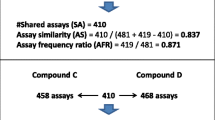Abstract
We have aimed to systematically extract analog series with related core structures from multi-target activity space to explore target promiscuity of closely related analogous. Therefore, a previously introduced SAR matrix structure was adapted and further extended for large-scale data mining. These matrices organize analog series with related yet distinct core structures in a consistent manner. High-confidence compound activity data yielded more than 2,300 non-redundant matrices capturing 5,821 analog series that included 4,288 series with multi-target and 735 series with multi-family activities. Many matrices captured more than three analog series with activity against more than five targets. The matrices revealed a variety of promiscuity patterns. Compound series matrices also contain virtual compounds, which provide suggestions for compound design focusing on desired activity profiles.








Similar content being viewed by others
References
Wermuth CG (ed) (2008) The practice of medicinal chemistry, 3rd edn. Academic Press, San Diego
Agrafiotis DK, Shemanarev M, Connolly PJ, Farnum M, Lobanov VS (2007) SAR maps: a new SAR visualization technique for medicinal chemists. J Med Chem 50(24):5926–5937
Wassermann AM, Bajorath J (2012) Directed R-group combination graph: a methodology to uncover structure–activity relationship patterns in series of analogs. J Med Chem 55(3):1215–1226
Cho SJ, Sun Y (2008) Visual exploration of structure–activity relationship using maximum common framework. J Comput Aided Mol Des 22(8):571–578
Schuffenhauer A, Ertl P, Roggo S, Wetzel S, Koch MA, Waldmann H (2007) The scaffold tree—visualization of the scaffold universe by hierarchical scaffold classification. J Chem Inf Model 47(1):47–58
Agrafiotis DK, Wiener JJ (2010) Scaffold explorer: an interactive tool for organizing and mining structure–activity data spanning multiple chemotypes. J Med Chem 53(13):5002–5011
Gupta-Ostermann D, Hu Y, Bajorath J (2012) Introducing the LASSO graph for compound data set representation and structure–activity relationship analysis. J Med Chem 55(11):5546–5553
Wawer M, Lounkine E, Wassermann AM, Bajorath J (2010) Data structures and computational tools for the extraction of SAR information from large compound sets. Drug Discov Today 15(15–16):631–639
Wassermann AM, Haebel P, Weskamp N, Bajorath J (2012) SAR matrices: automated extraction of information-rich SAR tables from large compound data sets. J Chem Inf Model 52(7):1769–1776
Kenny PW (2005) Sadowski J (2005) Structure modification in chemical databases. In: Oprea TI (ed) Chemoinformatics in drug discovery. Wiley-VCH, Weinheim, Germany, pp 271–285
Hussain J, Rea C (2010) Computationally efficient algorithm to identify matched molecular pairs (MMPs) in large data sets. J Chem Inf Model 50(3):339–348
Knight ZA, Lin H, Shokat KM (2010) Targeting the cancer kinome through polypharmacology. Nat Rev Cancer 10(2):130–137
Paolini GV, Shapland RH, van Hoorn WP, Mason JS, Hopkins AL (2006) Global mapping of pharmacological space. Nat Biotechnol 24(7):805–815
Hu Y, Bajorath J (2013) Compound promiscuity: what can we learn from current data? Drug Discov Today 18(13–14):644–650
Boran AD, Iyengar R (2010) Systems approaches to polypharmacology and drug discovery. Curr Opin Drug Discov Dev 13(3):297–309
Wawer M, Bajorath J (2011) Local structural changes, global data views: graphical substructure–activity relationship trailing. J Med Chem 54(8):2944–2951
Bemis GW, Murcko MA (1996) The properties of known drugs. 1. Molecular frameworks. J Med Chem 39(15):2887–2893
Xu YJ, Johnson M (2002) Using molecular equivalence numbers to visually explore structure features that distinguish chemical libraries. J Chem Inf Comput Sci 42(4):912–926
OEChem TKV (2013) April, Open Eye Scientific Software Inc, Santa Fe, New Mexico
OEDepict TKV (2013) April, Open Eye Scientific Software Inc, Santa Fe, New Mexico
Gaulton A, Bellis LJ, Bento AP, Chambers J, Davies M, Hersey A, Light Y, McGlinchey S, Michalovich D, Al-Lazikani B, Overington JP (2012) ChEMBL: a large-scale bioactivity database for drug discovery. Nucleic Acids Res 40:D1100–D1107
Knox C, Law V, Jewison T, Liu P, Ly S, Frolkis A, Pon A, Banco K, Mak C, Neveu V, Djoumbou Y, Eisner R, Guo AC, Wishart DS (2011) DrugBank 3.0: a comprehensive resource for ‘omics’ research on drugs. Nucleic Acids Res 40:D1035–D1041
Author information
Authors and Affiliations
Corresponding author
Rights and permissions
About this article
Cite this article
Gupta-Ostermann, D., Hu, Y. & Bajorath, J. Systematic mining of analog series with related core structures in multi-target activity space. J Comput Aided Mol Des 27, 665–674 (2013). https://doi.org/10.1007/s10822-013-9671-5
Received:
Accepted:
Published:
Issue Date:
DOI: https://doi.org/10.1007/s10822-013-9671-5




